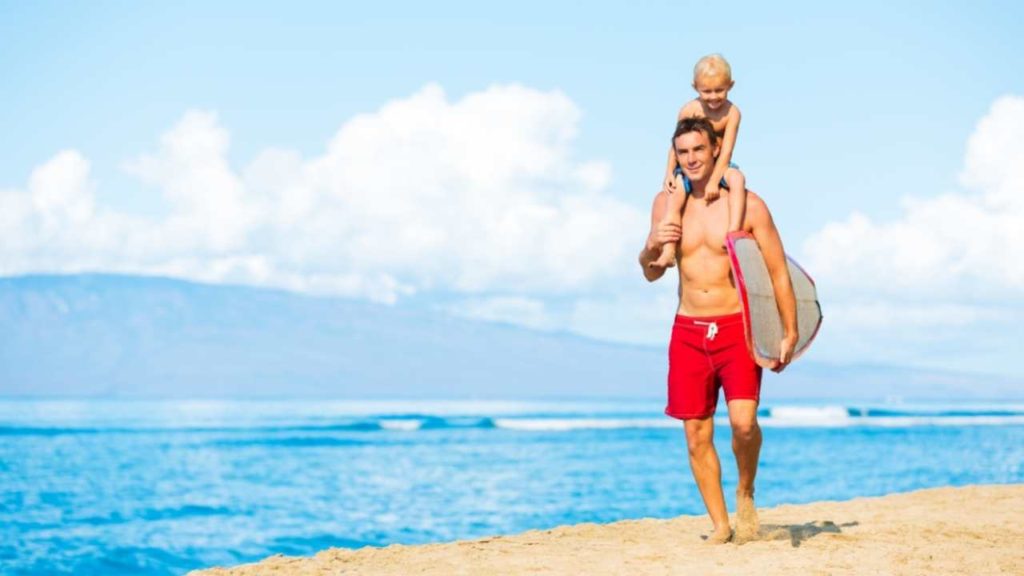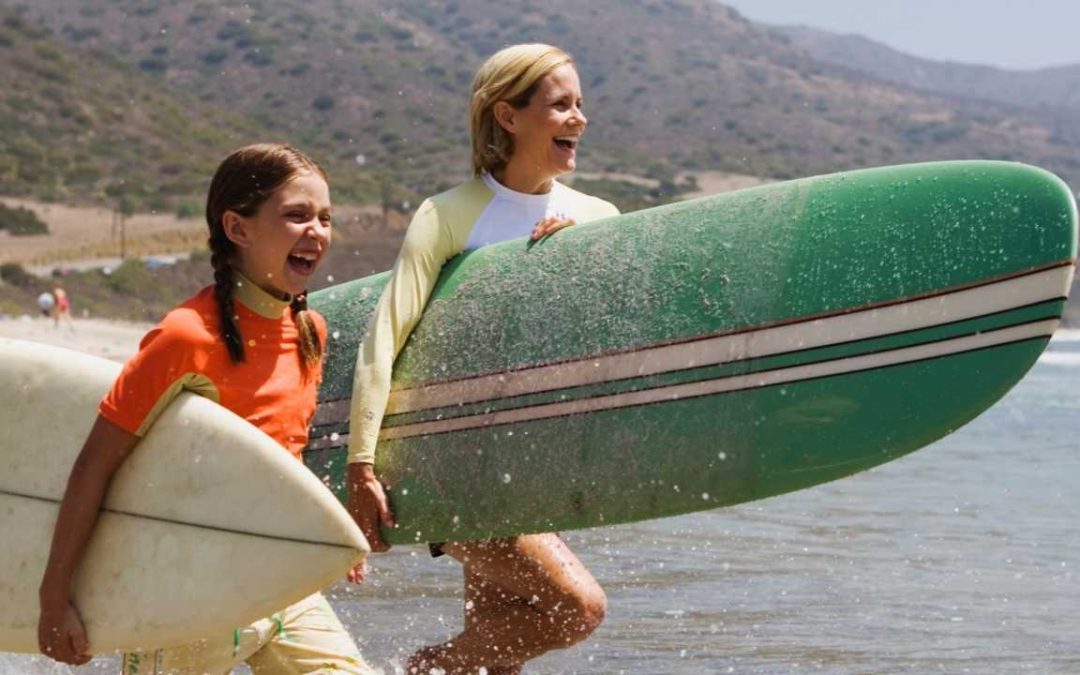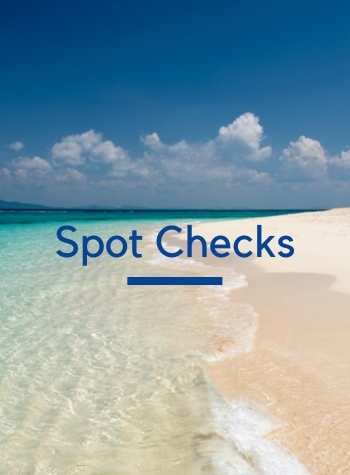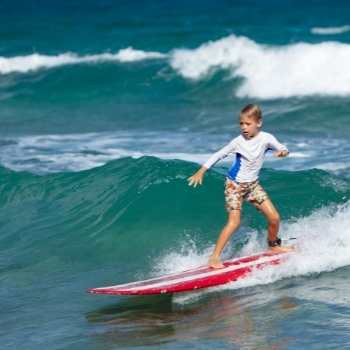Surfing is a difficult sport for anybody to learn, regardless of what age you are. Most surfers learn the sport when they are young, but there is an increasing amount of adults who are quickly picking up the sport.
There is no age limit for learning how to surf. What is necessary is a basic level of physical fitness, time, and commitment to actually make learning to surf possible. As we get older, both available time and fitness level tend to take a dramatic drop, but that can be fixed with commitment.
If youʻre feeling committed to learning how to surf, then youʻre almost there. With a little guidance, you can be calling yourself a surfer in no time.
I have made it my mission to share with you exactly what you need to know on your surfing journey. Whether you are starting your surf journey at 20, 30, 40, or 50, this post will give you exactly what you need to get you started.
What Itʻs Like To Learn To Surf, Broken Down In Age Groups
Letʻs be honest here, it is much easier to surf as a kid than it is as an adult. Most of it boils down to time. When I was a kid, all I did was surf. If the waves were flat, I went for a paddle, or a swim, or a run. If the waves were good, I would surf all day, every day. Who has that sort of time as an adult? And forget about it if you live more than a half-hour from the beach.
Why Surfing Gets Harder As You Age
LEARNING TO SURF IN YOUR TEENAGE YEARS
Unless you have a parent that takes you to the beach all the time when you are a kid so that you can surf, like the ones mentioned in this article, surfing in your teenage years is the best time to learn to surf.
As a teenager, you have certain freedoms that you did not have as a kid and certain freedoms you will not have as an adult.
First off, this only works if you are somewhat close to the beach. I would ride my bike or take the bus in my early teenage years to get to the beach. It would be impossible if I lived too far away from the ocean without being able to drive. Being able to get to the beach without having to rely on someone is huge.
I didnʻt need a job and I could get myself to the beach without help, that right there equals total freedom. All the time in the world to surf as much as I wanted.
Later in life, responsibilities begin to get in the way, but not so much yet as a teenager. When you are teenager, not only do you have time, but you have a young, flexible body that isnʻt as worried about looking like a kook while learning.
LEARNING TO SURF IN YOUR 20ʻs
Learning to surf in your 20ʻs is still a great time to get started. Commitments are still light and your body is still naturally capable of dealing with the dynamic movements of surfing.
Learning to surf while your body is still young has an advantage over learning when you are older. Injures are less common, the body still retains some sort of flexibility, and family and work commitments havenʻt quite taken over your life yet.
It may be a little harder on the ego having to look like a total kook in front of a cute surf instructor, but thatʻs a good lesson for a 20 year old to learn.
Youʻre driving now, can go to the beach whenever and wherever you want, but most likely have to head to a job so that you can pay the bills. Mommy and Daddy arenʻt taking care of them anymore.
So while you still have your youth, available time is starting to take a hit. I worked a job at a restaurant during much of my 20ʻs so that I could work and night and surf all day. It was a great lifestyle…for a while.
LEARNING TO SURF IN YOUR 30ʻS
Iʻd have to say that learning to surf in your 30ʻs might be the most difficult decade of your life to learn to surf.
While your body may still be in good physical shape, time is almost nonexistent. Unless you are single and live in your parents basement, you most likely have found yourself neck deep in a world of responsibilities.
Bills to pay, a significant other added to the mix, perhaps a new baby or little toddlers that eat up all your time, the idea of learning to surf sounds a bit selfish at this point, but not impossible.
This is where routine comes into play. With it and youʻll find yourself being able to sneak off for a little surf sesh, without it and watch your wave count disappear.
LEARNING TO SURF IN YOUR 40ʻs
Your 40ʻs are still a difficult time of your life to learn to surf, but things do get a little easier, while getting harder at the same time.
Hopefully you used your 30ʻs to set yourself up a bit financially. Your kids are bit older, perhaps theyʻre even willing to paddle out with you by now, but you can at least leave them on the beach by themselves.
This leaves you with the time that you need to learn how to surf. But with what you gain in time, you lose in physical conditioning.
Your 40ʻs are when ailments begin to show themselves in most average bodies. Slipped disks, torn ACLʻs, extra pounds. These injuries make learning to surf more difficult. But they can be remedied through exercise.
By hitting the gym a couple of times a week and keeping those joints limber, you should have no problem learning to surf in your 40ʻs, as long as you donʻt mind looking foolish for a while.
LEARNING TO SURF IN YOUR 50ʻs
As long as youʻve been taking care of your body, learning to surf in your 50ʻs is almost as good as learning to surf in your teenage years. Kelly Slater won the Pipe Masters a week before he turned 50, so there are no excuses, right?
At 50, you are more established in your career, kids are managing themselves and youʻve established more space in your relationship that carving out some “me” time is actually looked favorably upon.
You might even have enough money to take surf lessons from the best, like Surf Simply in Costa Rica.
What is key in your 50ʻs is how well your body can still perform. Flexibility, strength, and a certain lightness to your joints are needed to make it as a surfer at this age. With some yoga, cross training, and proper equipment, you should have no problem.
If you are a fifty-year-old woman wondering if it is still possible for you to take up the sport, let this post enlighten you a little.
Where To Begin The ʻLearn To Surfʻ Journey

Where to begin our surf journey? Many think it starts the moment you paddle your surfboard into a wave, but the journey actually begins before you even touch the water. Do you think youʻre ready?
Drop the Ego
The first step is mental. As we get older, it becomes increasingly difficult to accept that fact that you may not be good at everything. And believe me, learning to surf will demonstrate to you that you are, in fact, not good at everything.
You will fall. Your arms will flail all over the place. You might see kids paddle right past you and make it all look easy. You may even find yourself mixing it up with an angry local because you simply do not know the rules of the road when it comes to surfing.
Itʻs ok. Drop the ego. Accept that you are a beginner and embrace it.
At this stage, you are a kook. Take joy in the fact that your surfing is probably somebodyʻs entertainment for the day. Best thing to do, imagine you are a kid. What matters most to them is whether or not they can figure out how to do something, not how they look doing it.
Get In Shape
Your physical condition is just as important as your mental condition. If your body has a hard time going from the prone position to standing by popping up to your feet, then surfing is going to be hard.
If you have any back or joint injuries, you will want to strengthen your muscles around those areas so that you do not injure them again.
If you tire quickly, you will never be able to paddle into the lineup. Work on your stamina by running, swimming or riding a bike. Work on your flexibility with yoga.
A great program for working on your surf conditioning has been developed by Surf Strength Coach. They have a 12 week program that will get you into shape in no time. Be sure to check it out!
Equipment
Without the right equipment, you will have a difficult time. Itʻs almost impossible for someone who is 220lbs to be able to ride a surfboard the is 6ʻ long and only 2 ¼” thick. May as well be riding a piece of paper.
When you are just starting off, the best board for you is a soft top surfboard. If you are under 200lbs you can get away with a 8ʻ wavestorm board from Amazon.
For the rest of you, that soft top surfboard should be at least 9ʻlong like this Wavestorm found here. You need enough volume to keep you floating as well as the width and length of the board to keep you stable.
Time
This last one is something new surfers underestimate. Surfing takes up a lot of time, do you have any available?
As we get older, time becomes more of a precious commodity. There are so many other, more important things to do than surfing. Do you really have the 2+ hours it takes for each paddle out?
One of the best things I have done as time began becoming more scarce was to create a routine. I used to just try and surf when the waves were good, but I have found more surf time by choosing 2 specific days of the week that are dedicated beach days. They may not always coincide with the best surf, but at least Iʻm getting in the water.
A good watch helps keep the time in check while youʻre out in the water as well. I really enjoy the Rip Curl Surf Watch which you can order easily through Amazon. I not only know how much time I have left to catch another wave, but it logs and tracks all of the waves from my surf session as well. Now thatʻs cool!
5 Tips To Learn To Surf, Whether you are 20, 30, 40 or 50
So now that we covered the fact that you can surf no matter what age you are, letʻs go over a few tips to make sure you find success.
Just keep in mind, it took me a month to stand up on my surfboard and a couple of more months to begin going down the unbroken wave face, and I was 13 at the time. You may get it the first time out, or it may take a year. But if you really want it, just keep on practicing.
Take A Surf Lesson For Your First Time
If you have never paddle out before, especially if youʻve never swam in the ocean before, you should take a surf lesson.
Surf lessons have several benefits that you donʻt get if you just paddle out on your own.
- You get to try it out first before you buy your own equipment
- Your surf instructors will share knowledge with you that can take years to achieve
- There is someone else in the water making sure you are safe
- Others are there to motivate you
It is often overlooked how important those things are for a beginning surfer. It can be scary, paddling out into the ocean for your first time. Itʻs best to have a support team by your side.
Be sure not to take too many surf lessons. At some point itʻs up to you. Learn more about how many surf lessons you really need in this post.
Practice At A Sandy Beachbreak
After taking your first surf lesson, find a wide open beachbreak to practice at for the next time you go out.
Many websites will give you a list of the best beginner surf spots, but they fail to mention that they are normally really crowded.
When you are just starting out, finding a mellow wave with a sandy bottom and space from other surfers is the best thing you can do when. Save those beginner breaks for when you have already learned to paddle into waves, pop up, and can point yourself down the line.
When You Canʻt Surf, Skate
If youʻre like me and canʻt get into the water everyday, then try practicing on land. A great way to do this is with a surf skate.
A surf skate is a little different than a traditional skateboard. The trucks are designed to mimic the flow of surfing, so when you are riding a surf skate you can work on your surfing while on land.
There are a few surfskate models out there to choose from, but by far the fan favorite is Carver Skateboards. Carver Skateboards are the closet thing to surfing as you can get without being in the water. If you want more practice time, but canʻt get to the beach, then a surfskate is where itʻs at.
Observe The Ocean Regularly
When it comes to catching waves, ocean knowledge is just as important as physical skill. If you are unable to read the ocean conditions, wave direction and exactly where to be to paddle for a wave, I donʻt care how in shape you are in, it is going to be hard to catch it.
To improve your wave count, you need ocean awareness. You need to watch the surf constantly, on beautiful flat days and on days when the storm is raging. At high tide and low tide. When it is windy and when it is not.
If you donʻt have enough time to surf, but do have some time to check the conditions, do it! Watch how other surfers are catching waves. Pay attention to where the waves are breaking. How is the wind affecting the waves? Tides?
The more you can do this, the more ocean knowledge you will gain. You will soon notice that the best surfers have a deep connection with the ocean. If you want to get better, youʻll want to build your connection with the ocean too.
Create A Routine
As we age, time becomes more scarce. Find a way to get your surf time in by creating a routine. I am 40 now. It was hard for a while finding time to surf with a job to go to and little ones at home, but I found a few ways to make sure I get my water time, even though I had little time.
- Always keep a board on your car. I have missed so many chances to surf because I was just driving by the beach and was caught off guard by the good surf. That doesnʻt happen anymore.
- Create a regular schedule. I used to try and surf whenever the waves were good, but other engagements started to get in the way. Now I get 2 guaranteed days a week, Friday and Sunday, when I get to go to the beach no questions asked. While the waves arenʻt always epic, I do get more surf sessions in than I used to.
- Dawn patrols can be your best friend. I used to paddle out before first light while my family was still sleeping. I catch a couple of waves and they get to catch their zzzzʻs. Usually, Iʻd be back before they even got out of bed.
For a deeper dive into teaching yourself how to surf, be sure to check out this thorough guide teaching you how to do just that.
Final Thoughts
You can surf at any age, it just takes a little more flexibility as you get older than if you were a teenager.
There is a good reason I am still surfing 30 years after I first started. I guarantee you that you will not regret taking up the sport of surfing. Follow the tips and tricks in this post, get yourself in shape and enjoy surfing for years to come.



